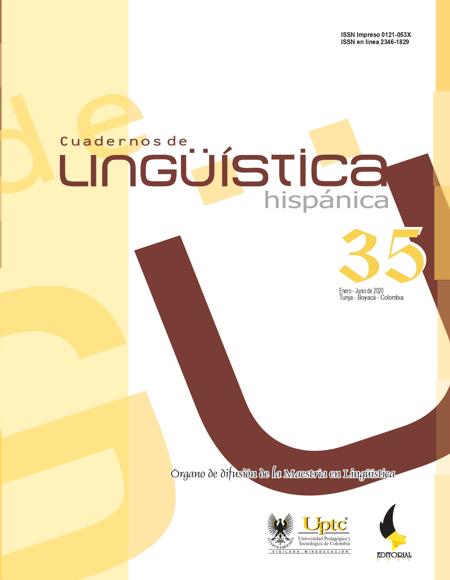Nominal Regular Polysemy by Metaphor

Abstract
This paper intends to analyze cases of possible nominal regular polysemy by metaphor. The analysis of these cases involves a review of the classical definition of regular polysemy proposed by Apresjan and developed primarily for metonymic extensions. From the advanced search in Diccionario del español de América y España (Dictionary of the Spanish of America and Spain) of possible cases of regular polysemy that respond to person and sensation hyperonymes, metaphorical and metonymic extensions are studied and the semantic dimensions in which the senses can diverge are analized. It is hypothesized that for there to be regular polysemy by metaphor, the senses of a group of lexical items must differ in paralell, which implies agreeing on three variables: a) the directionality of the polysemy, b) the non-descriptive meaning and c) the aspect on which similarity is based. It is concluded that there are three classes of regular polysemy by metaphor, although groups that exhibit an intermediate status are also detected.
Keywords
semantics; regular polysemy; metaphor
Author Biography
Marina Berri
Últimas publicaciones:
-Berri, M., & Bregant, L. (2015). Identificación de metonimias y metáforas: cuestiones metodológicas. Lenguaje, 43(2), 219-245.
- Berri, M. (2013). Neología semántica nominal y metáfora. Variedades del español de la Argentina: estudios textuales y de semántica léxica, 131-150.
- Berri, M. (2013). Léxico Generativo y aplicaciones lexicograficas: Los nombres concretos del dominio de la medicina en el DRAE. Revista signos,46(82), 190-212.
References
Apresjan, J. (1974). Lexical Semantics. User’s Guide to Contemporary Russian Vocabulary. Ann Arbor, MI: Karoma Publishers.
Berri, M. (2012). Representación lexicográfica de la polisemia regular y nombres con sentidos locativos: el caso ejemplar de las alternancias con sentidos abstractos. (Trabajo de fin de máster inédito). Universidad Nacional de Educación a Distancia, Madrid, España.
Berri, M. (2014). Polisemia regular en nombres locativos del español. (Tesis doctoral inédita). Universidad de Buenos Aires, Buenos Aires, Argentina.
Berri, M. (2019). Tipos complejos: una redefinición a partir de su comportamiento en corpus. Revista Signos. Estudios de Lingüística, 52(100), 481-501.
Briscoe, T. & Copestake, A. (1991). Sense Extensions as lexical Rules. In Proceedings of ACL SIGLEX Workshop on Lexical Semantics and Knowledge Representation (pp. 88-101). California: Berkeley.
Cruse, D. A. (2000). Meaning in Language. An Introduction to Semantics and Pragmatics. Oxford: Oxford University Press.
Cuenca, M.J. & Hiferty, J. (1999). Introducción a la lingüística cognitiva. Barcelona: Ariel.
Deignan, A. (2005). Metaphor and Corpus Linguistics. Amsterdam: John Benjamins.
Dos Santos, S. (2002). Computaçâo da polissemia regular em portugués. (Disertación de la Maestría en Lingüística). Facultad de Letras de la Universidad de Lisboa, Lisboa, Portugal. Recuperado de https://docplayer.com.br/35143192-Computacao-da-polissemia-regular-em-portugues.html
Kilgarriff, A. (1992). Polysemy. Brighton: University of Sussex.
Kövecses, Z. (2002). Metaphor: A Practical Introduction. Oxford: Oxford University Press.
Lakoff, G. (1987). Image Metaphors. Metaphor and Symbolic Activity, 2(3), 219-222.
Lakoff, G. & Johnson, M. (1990). Metáforas de la vida cotidiana. Madrid: Cátedra.
Lakoff, G. & Johnson, M. (1999). Philosophy in the Flesh. The Embodied Mind and its Challenge to Western Thought. New York: Basic Books.
Langemets, M. (2009). Systematic Polysemy of Nouns in Estonian and its lexicographic Treatment in Estonian Language Resources. Tallin: Tallin University. Retrieved from http://www.tlulib.ee/files/arts/96/HUM_A30062a0cd272d7a67416f36a6f76b8d7.pdf
Martínez, H., Bel, N. & Pedersen, S. (2012). A Voting Scheme to Detect Semantic Underspecification. In N. Calzolari, T. Declerck, M. Dougan, B. Maegaard, J. Mariani, A. Moreno, J. Odick & S. Piperidis (eds.) Proceedings of the Eight International Conference on Language Resources and Evaluation (LREC’12). Estambul: European Language Resources Association (ELRA).
Nunberg, G. & Zaenen, A. (1997). La polysémie systematique dans la description lexicale. Langue Française, 113, 12-23.
Peirsman, Y. & Geeraerts, D. (2006). Metonymy as a Prototypical category. Cognitive Linguistics, 17, 269–316.
Peters, W. & Kilgarriff, A. (2000). Discovering Semantic Regularity in Lexical Resources. International Journal of Lexicography, 13(4), 287-312.
Pustejovsky, J. (1995). The Generative Lexicon. Cambridge: MIT Press.
Pustejovsky, J. & Batiukova, O. (2019). The Lexicon. Cambridge: Cambridge University Press.
Ravin, Y. & Leacock, C. (2000). Polysemy: Theoretical and Computational Approaches. Oxford: Oxford University Press.
Rojas, D. (2010). El tratamiento de la polisemia regular en diccionarios monolingües de español. (Tesis de maestría inédita). Universidad de Chile, Santiago de Chile, Chile.
Shmelev, D.N. (1969). Problemy semanticheskovo analiza leksiki (na materiale russkovo jazyka). Moscú: Nauka.
Steen, G. (2017). Identifying Metaphors In language. In E. Semino & Z. Demjén (eds.), The Routledge Handbook of metaphor and Language (pp. 73-87). London/New York: Routledge.
Sánchez, M. (2006). Creación lingüística: la renovación del léxico actual por la metonimia. Recuperado de http://www.tesisenred.net/bitstream/handle/10803/10941/Sanchez-Manzanares_Tesis.pdf?sequence=2